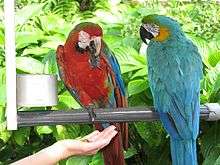Hybrid macaw
Hybrid macaws are the product of cross breeding of more than one species of macaw, resulting in a hybrid. They are often characterized and bred for their unique and distinct coloring, and for this reason, are highly sought after and valued in the exotic pet trade. Macaws are native to tropical North and South America.[1] Hybridization of macaws occurs both in nature and captivity, being one of the few species that can produce viable, fertile offspring unlike many other hybrids produced from crossing different species resulting in sterile hybrids with factors that limit their success of survival[2] (e.g. the liger and mule). Hybrid macaws do not hold any scientific names, and are often labeled by the two macaw species they are produced from (e.g. scarlet macaw × green winged macaw)
| Hybrid macaw | |
|---|---|
 | |
| Hybrid macaw (left) with blue-and-gold macaw | |
| Scientific classification | |
| Kingdom: | Animalia |
| Phylum: | Chordata |
| Class: | Aves |
| Order: | Psittaciformes |
| Family: | Psittacidae |
| Subfamily: | Arinae |
| Tribe: | Arini |
| Genera | |
There are 19 species of macaw, many of which can produce up to three generations (potentially more) of hybrids. Generation F1, being the most common, has the widest variety of hybrids and are the most popular and well known. Hybrid macaws are also often viable in generation F2 which means they are able to reproduce, unlike generation F3 and later due to a rising rate of sterility. The most popular hybrids include crossing with the blue and gold macaw, military macaw or scarlet macaw.
Because macaw species are able to hybridize and produce viable offspring, scientists study and breed them in captivity to better understand hybridization, and understand their importance in preserving endangered macaw species. A study performed of the hybridization between the last wild Spix's macaw and an Illiger's macaw, provides evidence and important information that could potentially help establish endangered wild populations of the Spix's macaw, demonstrating how vital hybrid macaws are.[3]
Hybrid macaws in nature
The hybridization of macaws in the wild is less common than in captivity due to natural barriers and mating behaviors, although a few rare cases have been recorded. One example was the natural hybridization of a Spix's and Illiger's macaw recorded in Conservation Genetics (2001), which demonstrated two species of macaws producing viable offspring. Due to the fact the Spix's macaw is now thought to be extinct in the wild, this discovery created a major break through in the preservation of this species and macaws as a whole as it is understood that the Spix's macaw may now be fully extinct.
Due to deforestation and the capturing of wild macaws for the exotic-pet trade, it is likely that the hybridization of macaws may increase in the wild in efforts to conserve their species and reproduce.
Hybrid macaws in captivity
The hybridization of macaws is usually due to the placement of multiple macaw species in the same enclosure. Breeders may choose to pair different species to intentionally produce hybrid offspring, or the parrots themselves may select such a partner due to a lack of a suitable conspecific of the opposite sex. Due to the rising interest in hybrid macaws in the exotic-pet trade, production has increased. Their distinct coloring makes them highly sought after by competitive and exotic-bird breeders and traders.[4] They are also bred for their "pet quality" and personality traits which results from the mixing of two species of birds. One example is the hybridization of the Catalina macaw, which is bred for its intelligence and ability to respond to training, and the harlequin macaw, bred for its relaxed and calm personality. Although, behavior, temperament and coloring can vary from each hybrid.
Recently there has been an over abundance of female blue-and-yellow macaws in captivity, and they have been highly hybridized.
Macaw hybrid breeding types/generations
First-generation macaw - F1
.jpg)
First-generation hybrid macaws are the most popular and abundant macaw hybrids.[5] Examples:
- Bluffon's macaw (Buffgold macaw) = blue-and-gold macaw × Buffon's macaw
- Ruby macaw = scarlet macaw × green-winged macaw
- Catalina macaw = blue-and-gold macaw x scarlet macaw
- Verde macaw = scarlet macaw × Buffon's macaw
- Calico macaw = green-winged macaw × military macaw
- Miligold macaw = blue-and-gold macaw × military macaw
- Harlequin macaw = blue-and-gold macaw × green-winged macaw
- Emerald macaw = Buffon's macaw × hyacinth macaw
- Caloshua macaw = blue-and-gold macaw × hyacinth macaw
- Shamrock macaw = scarlet macaw × military macaw
Second-generation macaw - F2

Examples:
- Flame macaw = green-winged macaw × Catalina macaw
- Harligold macaw = blue-and-gold macaw × harlequin macaw
- Jubilee macaw = green-winged macaw × harlequin macaw
- Camelot macaw = scarlet macaw × Catalina macaw
- Rubalina macaw = ruby macaw × Catalina macaw
- Starlight macaw = scarlet macaw × miligold macaw
- Tropicana macaw = scarlet macaw × harlequin macaw
Third-generation macaw - F3
Examples:
- Camelina macaw = Camelot macaw × Catalina macaw
- Fiesta macaw = Camelot macaw × harlequin macaw
- Capri macaw = Camelot macaw × scarlet macaw
References
- Pranty, Bill; Feinsstein, Daria; Lee, Karen (2010). "Natural History of Blue-And-Yellow Macaws (Ara ararauna) in Miami-Dade County, Florida": 55–62. Retrieved 10 May 2019. Cite journal requires
|journal=(help) - Grant, Peter; Grant, Rosemary (10 April 1992). "Hybridization of Bird Species". Science. 256 (5054): 193–197. Bibcode:1992Sci...256..193G. doi:10.1126/science.256.5054.193. PMID 17744718.
- Miyaki, Christina; Faria, Patricia J.; Griffiths, Richard; Araujo, João C.C.; Barros, Yara M. (2001). "Conservation Genetics". 2: 53–55. doi:10.1023/A:1011584225656. Cite journal requires
|journal=(help) - Abramsion, Joanna (1 April 1995). The Large Macaws: Their Care, Breeding, and Conservation. Raintree publications. ISBN 978-0963596406.
- McCarthy, Eugene M. (2006). Handbook of Avian Hybrids of the World. Paul B. Hamel. ISBN 0-19-518323-1.